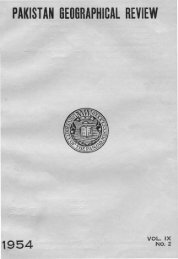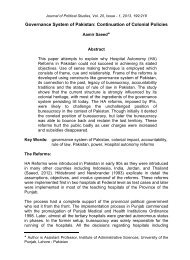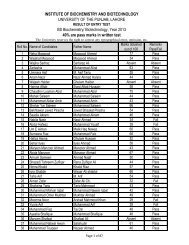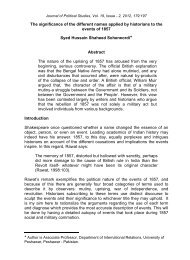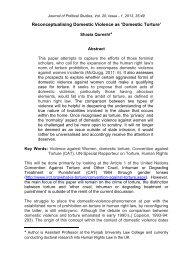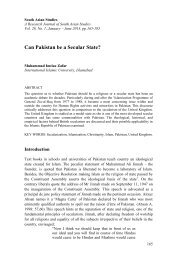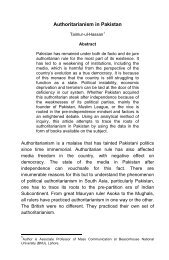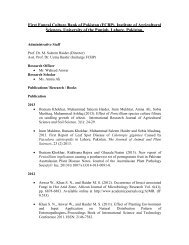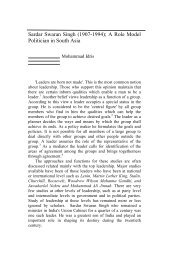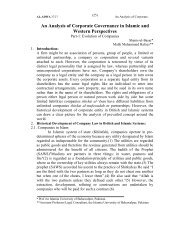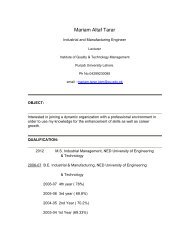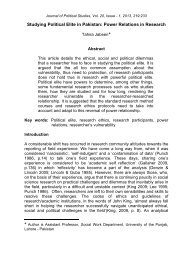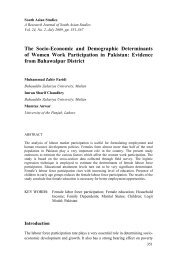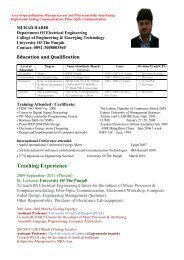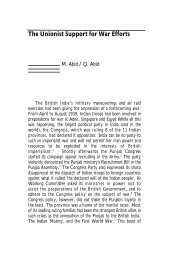You also want an ePaper? Increase the reach of your titles
YUMPU automatically turns print PDFs into web optimized ePapers that Google loves.
The Central Curriculum of Education: the praxis of be(com)ing human<br />
ABSTRACT<br />
The Central Curriculum of Education:<br />
the praxis of be(com)ing human<br />
Bas key dushwar hei har kaam ka asaan hona<br />
Aadmi ko bhi moyasir nahin insaan hona<br />
(Asad ullah Khan Ghalib i )<br />
As difficult it is for everything to be easy,<br />
So man strives to be fully born as a human being.<br />
(literal translation- <strong>Sohaila</strong> <strong>Javed</strong>)<br />
If only, like dialectic<br />
s/he lets a naked nerve on parole:<br />
a kind spectacle<br />
of wet air augurs<br />
self to witness its own guest: itself<br />
for becoming that it is not- human.<br />
(Interpretation - <strong>Sohaila</strong> <strong>Javed</strong>)<br />
“In a fear- inspiring way I am wonderfully made.”<br />
(Psalm 139: 14)<br />
And not done, till I wonderfully become.<br />
5<br />
(<strong>Sohaila</strong> <strong>Javed</strong>)<br />
This piece (written in response to reading about our environmental crises,<br />
especially concerns raised by Erazim Kohak, 1999) is an invitation to<br />
readers for an intentional and reflective pause, as reflecting subjects, to<br />
step inside self so as to experience the marvels of progression from mere<br />
human being unto becoming human. Its essence is reciprocity between<br />
these two evolving moments of self, the first prior awakening to essential<br />
self, and then, functioning that potentiality into actuality for it determines<br />
“the entity to be and to become what it potentially is…” (Shalom, 1984).<br />
This paper amounts to looking at the form-matter unity from inside the<br />
unity, and then, working out of our status quo, becoming our own active<br />
outsider. Its investigatory purpose arises as a coming-in response to our<br />
contemporary awakening to spirituality, and the pedagogical implications<br />
of such a response. This reflective piece has words and poetry in italics<br />
that is my creation, Reference (words carrying superscript), Glossary<br />
(words in bold), and Bibliography sections.
<strong>Sohaila</strong> <strong>Javed</strong><br />
Here perhaps begins a deep undertaking of life--discovering a dimension<br />
of depth-- religious, mystical and ethical, or in just one word, spiritual,<br />
which life may hold for humans. To seek is to delve into Self, self and life<br />
for real seeing, Self-realization and self-realization--the undeniable<br />
interconnections that en(twin)e humans as biotic particles in the stream of<br />
life. Understanding life as a good and meaningful gift, coming from<br />
Source of Life to living beings, intensely evokes wonder and in/forms<br />
reality. Also, a humane approach to its meaning and value invites<br />
presence and participation, recognition and acceptance, offering immense<br />
possibilities to creatively become all that we are capable of becoming.<br />
Perhaps, herein lies the desire for creative response and personal<br />
responsibility. It is an assignment of lifetime and the meaning of our<br />
being and the value of our becoming, celebrating sacred bio-centrism in<br />
its own small way. So here I am, thinking through the fundamental issue<br />
of human „being‟ upon this sacred earth and its related proximal<br />
development, and the inalienable possibility of what becoming human<br />
means. It is not without good reason for companions of this now not-sobeautiful<br />
earth, whose unbecoming exactly parallels our just being<br />
human. If only we would understand------<br />
That is the intended magic and wise thought consuming serious thinkers<br />
the world over, and making ways to our centrist ethos for knowing how to<br />
survive as intelligent, sane, sensitive beings of the best kind, namely, the<br />
human kind, inhabitants of the same good Earth until the end of time.<br />
The purpose of this paper is to share with readers a philosophical<br />
reflective research concerning human presence on the earth at a time<br />
when humankind can no more str/etch a little to be more. It is a matter of<br />
attitude, heart perception, conceptualizing intention, will, and desire to<br />
remain human in passivity or become human in accordance with our<br />
ideological or imaginative perception of what might be or ought to be,<br />
and the status of human being thereafter–that is a philosophical human<br />
question. It involves a human quest of searching ways, of knowing that<br />
are not alienable to humans. Calling and coming to seek them is the most<br />
appropriate and authentic response. We can, if desirable, construct a<br />
model of sustainable lifestyle and then, live that style. Our task and true<br />
commitment would be to work on that style in artful reconstruction as an<br />
aesthetic ethics praxis, so important from the perspective of our human<br />
individuality and humanity. It is, verily I think, our task and the meaning<br />
of our being. For our continuity and sustainability, we need to seek out a<br />
sustainable mode of peaceful coexistence and then, what we necessarily<br />
6
The Central Curriculum of Education: the praxis of be(com)ing human<br />
need is the spiritual courage and determination to live that way of being.<br />
Is that being educative? Spiritual? Sacred?<br />
If only we desire------ yes, desire is the great imperative, an abstraction,<br />
yet a uniqueness that arises in the heart, and consumes us wholly for a<br />
better possibility through education. As long as we consider ourselves<br />
always within the limits of growth, and consider expansion and<br />
enhancement impossible, not even the best ways can help us. However,<br />
with the desire to excel, constraints such as that of time, mortality and our<br />
vulnerability to painful experiences serve as moderation, willing us<br />
meezan (balance) to keep us in the straight way that generates right<br />
action, and is noble and beautiful for the joy and serenity it brings. A<br />
passionate desire, here, simply makes a way for going even be-yond the<br />
limits, and putting essential being and knowledge into action. It is<br />
therefore not simply a „living‟ question but one that conceives of human<br />
living in the ecological context, and makes the simple teacher-learner<br />
interaction in a compassionate ethos appear as eco-pedagogical<br />
philosophy of an ethical world that is the ethology of teaching. The point<br />
is to sign a simple accord with nature and reinterpret human nature in<br />
accordance with it, and then, bring human law to confirm the accord as<br />
Kant would say. This is a possibility–dismissing it altogether seems<br />
pointless. And rightly so, C. S. Peirce asks us not pretend to doubt in<br />
philosophy what we do not doubt in our hearts. That would be a prime<br />
silent teaching for an educator in any discipline, and a singular note to<br />
know this educator as a teacher for this is essentially what education is<br />
about.<br />
This understanding in/forms participatory existence and gets informed<br />
through the symbiotic way of deconstruction and reConstruction for<br />
human understanding. This is a personal testament of faith and passionate<br />
concern. The emphasis here shifts from relations to relationship, from self<br />
to „you and me‟ as „us‟ in our embodied amness that is compassionate<br />
and conscious. As Richard Falk implied, a passionate relationship is<br />
richly relational, and which has the reality of internal relations abides, and<br />
is unabiding, infinite, and eternal. This is where the human story begins–<br />
the sacred Source, home that is not wholly transcendent but always within<br />
heart, where the entire creation gathers to meet, experience and feel<br />
related. Out of this core, grows heart‟s content, embodied as reflected<br />
expressions of creative communication and compassionate practice of a<br />
living curriculum. The eco-pedagogical con(texts) undertake “the<br />
7
<strong>Sohaila</strong> <strong>Javed</strong><br />
humanness of human beings” (Madison, 1988, p. 154) as a response to the<br />
metaphysical questions, “What is „man‟?” and “What is man‟s place in<br />
nature?” And then, we see ourselves embedded in the numinous dynamics<br />
(Swimme, 1999) of a compassionate ethology, the ethics of living in<br />
Education 1 and a willful desire that every human be<br />
pure<br />
transparent<br />
humanness.<br />
Of hum/animal relations<br />
Leading preponderant lives for many incredible centuries makes us speak<br />
of „humans and animals‟ as distinctive beings in the pedigree of creation<br />
(Kohak, 1999). Obligated by self-glorification, and the element of nonhumanness<br />
that we associate with animals, we assumed that animals are<br />
random objects, lower in demeanour, felled as they are on four legs. So<br />
alien in comportment, these poor, bare creatures seem God‟s cynical tryst<br />
or diabolical miscue on the world stage. Casting them away as aliens, we<br />
had our own world and life as animate beings, processed by our social<br />
order and possession of human potentialities that we could never associate<br />
ourselves with animals, as partners of one life-world. Disconnection from<br />
the animal kingdom has diminished us tremendously. We are less, not<br />
more, by this missing connection. Whatever we speak ill of, diminishes<br />
us, since all forms of living beings without exclusion are connected to us,<br />
and are integral to our being. The egotistical sublime (John Keats, 1818)<br />
in us grows and gives us an attitude of anti-biocentrism--an attitude based<br />
on disrespect of all life, and the pledge to destroy life rather than care for<br />
it, far from celebrating it.<br />
This is the underpinning thought of human consciousness, arising as it did<br />
from taking a literal understanding of the conception of a hierarchical<br />
ordering of „higher‟ and „lower‟ beings, and consequently its meaning and<br />
value to humans, being the centrist ethos of God‟s creation. Their<br />
pertinacious coming from above in the sequence of God-angels-humans,<br />
while all other life rises from below, in the sequence of matter-plantsanimals<br />
insists on the idea of total separation. It still impinges upon our<br />
consciousness and modes of existence, and defines human-animal and<br />
human-human relations in a way that makes the concept of humans as the<br />
crown of creation, endowed with an immortal soul, active intellect at the<br />
time of birth as problematic.<br />
8
The Central Curriculum of Education: the praxis of be(com)ing human<br />
The meaning of this sequence should not be „higher‟ or „lower‟ in the<br />
conventional sense. Rather, it should be about human responsibility to use<br />
this intellect, and human capacity to care and be responsible. Of course, in<br />
their sense of freedom, I think, they can do practically anything they wish.<br />
When indeed, we need to rethink the notion of freedom for it shouldn‟t be<br />
defined as freedom to do anything, for then, it creates those conditions<br />
that prevent us from fulfilling the human potential to be really<br />
enlightened. Our less humanistic worldview today robs us of true<br />
EnLightenment. Instead of liberating us from pretence, prejudice and<br />
differentiation, we are caught up by the sole significance of humans and<br />
their dominating wishes. What else is, insignificant?<br />
The value of enlightenment and its significant use lies only in serving or<br />
resisting human wishes. However, the thought it engenders is for the<br />
enlightened to have value, insisting upon humans the position of the<br />
master, and the will for possession and power or to slavishly live the will<br />
of the master. It also presupposes our status as „higher‟ beings, free of all<br />
consideration toward lower beings as the other. Our self-regarding<br />
instinct, in order to accommodate the „survival instinct‟ by recognizing<br />
our „inherent‟ right to self-defense and self-glorification, called<br />
psychological egoism, has practically driven us into master-slave<br />
relationship with all those we consider as the Other. Kohak (1999) fears<br />
that these lesser order beings, so labeled for their ordinary peripheral<br />
existence, and less privileged status, are excluded from visibility,<br />
understanding and responsibility towards them, based as it is upon the<br />
ideas of human superiority and human distinctiveness.<br />
This is where I encounter points of difference with the dominating<br />
thought of (un)enlightened beings. The moment is insistent and calls for<br />
an intentional and reflective pause. It reminds me of “classic thought 2 ,<br />
dominated by Aristotle that created vitalism by endowing living systems<br />
with a non-material purposeful driving component that attained<br />
expression through the realization of their forms.” Continuing this talk in<br />
the preface to Autopoiesis and Cognition (1980), Sir Stafford Beer<br />
confirms that<br />
Thence, under the pressure of unavoidable experience and the definite<br />
thrust of Cartesian thought a different outlook emerged, and mechanism<br />
gradually gained the biological world by insisting that the only factors<br />
operating in the organization of living systems were physical factors, and<br />
that no non-material vital organizing force was necessary. (p. 74)<br />
9
<strong>Sohaila</strong> <strong>Javed</strong><br />
Maturana calls this “non-material” vitalism “spirit,” and finds it invested<br />
with Self-organizing unity. It brings me to the Aristotelian interpretation<br />
of humans as spirit-mates of God-Spirit with their active intellect while<br />
animals with their passive intellect are enjoined with mental activities,<br />
consciousness, emotions, understanding. All these external manifestations<br />
of the soul or psyche, Aristotle‟s passive intellect or mere “animality”<br />
fleshed out in animals, the lesser beings walking on four legs. These poor,<br />
bare, unaccomodated creatures, devoid of value, dependent for it on<br />
humans and their wishes, treated as raw material, base material organism,<br />
flawed at birth, God‟s brute, our non-human kin, mere animals. When, in<br />
truth we are the most dependent creatures! We want them, Kohak<br />
protests, even their furs and toil!<br />
That makes it important for me to seek out the external manifestation of<br />
that human spirituality which evinced much amazement from<br />
Shakespeare‟s Hamlet:<br />
What a piece of work is man! How noble in reason!<br />
how infinite in faculties! in form and moving, how<br />
like an angel! in apprehension, how like a god! The<br />
beauty of the world! The paragon of animals!<br />
10<br />
(Act II, Scene ii, 303-307)<br />
This fine quintessence of ethereal composition wins godly designation as<br />
the “locus of permanence” (Shalom), the immortal spirit s/he shares with<br />
God-Spirit. Is this enough to guarantee humans their alleged exceptional<br />
status as human beings, the crown of creation (ashraf ul makhluqat ii )? Or<br />
something more that becomes a strong impetus for me to come to a<br />
startling realization about humans as the hum/animal.<br />
The Metaphysics of human (Inter)Subjectivity<br />
“Mr. Palomar thinks that every translation requires another<br />
translation, and<br />
so on…Yet he knows he could never suppress in<br />
himself the need to translate, to move from one<br />
language to another, from concrete figures to<br />
abstract words, to weave and reweave a network of
The Central Curriculum of Education: the praxis of be(com)ing human<br />
analogies. Not to interpret is impossible, as refraining<br />
from thinking is impossible.”<br />
And what about translating the Other<br />
11<br />
(Calvino, 1985)<br />
A reconnection is imperative in order to end the impossibility of<br />
interpreting the Other as “locus of permanence” (Shalom, 1984), an<br />
immaterial some-thing, that provides an epistemological springboard for<br />
attaining truths about Reality. Since I know that I am, I cannot doubt that<br />
I exist. This proves, as Saint Augustine argued “there are truths that I can<br />
attain to; it proves the existence not only of a substantial soul but also,<br />
ultimately, that of a metaphysical or onto-theological God which, as pure<br />
being, is also absolute, immutable substance” (De Civitate Dei, xi, p. 26).<br />
The permanent locus of the embodied human being determines that it will<br />
become what it potentially is. This is that specific particular that<br />
explicates itself spatio-temporally in the existing physical temporality as<br />
“an actually existing timeless potentiality indefinitely actualizable as a<br />
result of actions which refer back to it, or which stem from it (Shalom,<br />
1984). It requires a temporal-time frame to be understood conceptually,<br />
and observed experientially, but essentially is the “locus of permanence,”<br />
and therefore beyond the temporal mode of existence. This is the same<br />
specific particular that is essentially present in the human self as “a locus<br />
of permanence which then, explicates itself spatio-temporally as the<br />
development of „that specific particular,‟ ” a part of the physical entity as<br />
a whole. This “unitary particular or individual” continues to actualize<br />
itself in the world, and manifests itself thus as necessity.<br />
Albert Shalom 3 , a metaphysician of subjectivity, in speaking about this<br />
self-determining activity “the internalization within the locus of<br />
permanence of its own processes as identity,” tells us:<br />
this locus of permanence is not to be conceived as a<br />
separate entity, an entity apart from the physical entity as<br />
a whole, but as the permanent<br />
locus of that physical entity as a whole determining the entity<br />
to be and to become what it potentially is…. (p. 269)<br />
Its principal functioning determines those reactions as potential responses<br />
to its actualizing potentiality. And what this potentially is, it becomes in
<strong>Sohaila</strong> <strong>Javed</strong><br />
its actualization, further determining that this locus of permanence is “a<br />
center of power.” This centralized power is the dynamism that Aristotle<br />
conceived as the specific particular of animate organisms, and is Being‟s<br />
distinctness with infinite creative intention and capacity for the perennial<br />
unfolding of this unitary “specific particular.”<br />
Witnessing this principal functioning in creative performances is another<br />
experience of the center of power, determining to itself the entity to be<br />
and to become what potentially it is capable of. The externalization to this<br />
effect is experiencing the internalization within the locus of permanence<br />
of its own original identity. This is the permanent status of dynamic<br />
being, and needs to stay as an actualizing becoming entity as Albert<br />
Shalom tells us even more:<br />
„experiencing‟ is a particular mode of the reflecting, or<br />
internalizing, of specific spatio-temporal energy<br />
transactions of particular identities or loci of<br />
permanence. That is to say, from this standpoint,<br />
„experiencing‟ is a derivative reality from the more<br />
fundamental principles of the constant dialectic within<br />
living and sentient organisms and actualized by means of<br />
their particular identities or loci of permanence. (p. 270)<br />
As essence experiences its immutable truth, the identity that is conceived<br />
at this significant time, determines and defines the specific sort of identity<br />
it is to itself. This means<br />
the transformation of incessant and physical processes<br />
into a quasi-timeless<br />
analogue of the constant repetitions of these physical<br />
processes themselves…. In other words, the varied mass<br />
of bodily processes, as they are internalized in the locus<br />
of permanence or identity, constitute the emergence<br />
within that identity of a sense or a feel of that identity<br />
itself. (p. 271)<br />
What arises is a new subjectivity--a new Self with the sense of organism‟s<br />
identity reflected or internalized in the locus of permanence, through and<br />
by means of that specific process which defines that locus as a „self‟ or<br />
identity of a specific kind. This permanent locus operates, and it is a<br />
transforming of particular kind, of the physical and spiritual processes<br />
12
The Central Curriculum of Education: the praxis of be(com)ing human<br />
that constantly remind us of our immense potentiality, and pertinacious<br />
becoming power. Senseless sensation, being a physical process, is<br />
constantly succeeded by fresh reminders of consummate being in this<br />
active moment, and that affords some kind of vicarious understanding of<br />
ourselves, the semantically exact, homogeneous idealities (Shalom, 1984)<br />
that spiritual activity as potentiality affords them to be. This is another<br />
way of knowing about our true subjectivity and desirability of selfchange.<br />
Resistance to such phenomenological understanding is the breeding<br />
ground of senseless narcissistic we. Therefore, remaining open to our<br />
interested and living subjectivity actually opens up an alternative practice<br />
of discourse which emphasizes its act, character and situatedness (in<br />
Madison, 1988, p. 174), and becomes what the Japanese call yu-mu, a<br />
pure site for shifting configurations and immense possibilities. Since I<br />
cannot doubt that I exist on this site, more alive I am as a specific<br />
particular in subjective experiences that determine my particular identity<br />
as a subjective human, I endorse progressive positiveness that purity of<br />
heart, mind and soul feels, engenders and posits. This proves there are<br />
truths I can attain to; it proves the existence of a substantial soul or<br />
intellect that is in constant discourse with other soul entities that human<br />
(inter)subjectivity opens me to. This is pure subjectivity in review of<br />
metaphysics, as it gets formed in the presence of true Being and infinite<br />
becoming capacity. The inevitable question is what does this leave us<br />
with? Here we run into the „end of philosophy‟ theme: the human<br />
meaningness of self as the beginning of human action.<br />
What more of this animal<br />
This “paragon of animals,” as Shakespeare has cited human, has more<br />
traits than mere chance would grant, such as „upright‟ posture, clothing, a<br />
feelingly expressive face, speech, reason and freedom as essential signs of<br />
humanity. Human ability to speak becomes power when s/he captures the<br />
fleeting moments in concept, and gives them habitation in written form as<br />
word, an immediate capturing of moving thoughts and flying images, an<br />
important distinctive feature of that ennobling spirit so magnanimously<br />
given to human beings as birthday gift. And the soul, that both human and<br />
animal inherit, and for human consciousness to make it intellect, and<br />
worthy of intellectual pursuits!<br />
13
<strong>Sohaila</strong> <strong>Javed</strong><br />
Erazim Kohak (1999) thinks that the entire imposing construction of<br />
human civilization is based on this ability. Further traits as mere<br />
possession and their profitable use are more empowering and<br />
distinguishing notes for humans. Theirs is an exemplary power to define<br />
“ideal relations among components of experience.” Reason and<br />
understanding, and the possibility of comprehensive and creative<br />
imagination, makes them capable of not only building things in the air,<br />
and encountering them as local habitation and name (Shakespeare). It is<br />
the capacity of imagining them as khayal (image) in ideas and concepts,<br />
and then languaging them, and giving them many visual lives. Human<br />
capacity for both is not just a capacity. This image-making faculty,<br />
intensified through the intellect and appearing as a whole mélange of<br />
“non-actual possibilities,” becomes the basis of human freedom, and also<br />
of accepting critically what there is from the choices we see and<br />
apprehend in material and immaterial forms as could be or should be. Or<br />
else, as Hamlet apprehended:<br />
What is a man,<br />
If his chief good and market of his time<br />
Be but to sleep and feed? a beast, no more.<br />
Sure he that made us with such large discourse,<br />
Looking before and after, gave us not<br />
That capability and godlike reason<br />
To fust in us unus’d.<br />
(Act IV, Scene V)<br />
These frightening possibilities thus assign us the moral/ethical<br />
responsibility of owning our choices and using them positively on the<br />
ever-expanding spiral journey we embark upon, delighting the<br />
Transcendent Other (Huebner) along the way, and simultaneously<br />
affirming our soul enlargement (Eckhart). And what would delight God<br />
more is remembering You in acts of prayer and meditation, and the ethics<br />
of living responsibly--sacred for the very deep, inalienable and<br />
irrevocable connection formed when He had “breathed part of My Spirit”<br />
(The Quran) to us at the time of our birth. And the integrity of our<br />
animate being is to manifest our “immortal spirit” that defines our birthright,<br />
and our ethical responsibility to perform it sensibly and also<br />
joyfully. It has to be seen as a moral and spiritual response for only then it<br />
can generate the action. For in the educational domain, such an action<br />
needs to be generated–action that has positive value, is broad-based,<br />
includes all, and is instrumental to our spiritual growth and development<br />
14
The Central Curriculum of Education: the praxis of be(com)ing human<br />
as human individuals with humanness. As doing subjects, we always need<br />
to go beyond what we know, and quite rightly put into effect what we<br />
know, otherwise to what effect is our being as knowing subjects, our selfrealization,<br />
and our state of knowing too, I contend.<br />
My seeing contention is that human bodies gain the dignity of human<br />
beings only when we embody our spirituality, make positive use of the<br />
given faculties, as outward manifestation of our God-Spirit. We need to<br />
make wise choices, rather than refuse the signs of humanity as<br />
undesirable faculties, defying humanity in the indefatigable way we have<br />
been doing egotistically for the purposes of self-regard or under the guise<br />
of self-defense against extremism. Otherwise, I think that we have never<br />
simply become human, and so have no right to this deference. We have<br />
remained human, merely being with the mere possession of innate<br />
wisdom and goodness, imagining ability, reason and speech and higher<br />
intelligence as soul, capability of recognizing moral responsibility, or are<br />
hum/animal, another species with mere “animality”--the soul or psyche,<br />
with Aristotle‟s passive intellect. Only with the actualization of that<br />
equipment called active intellect, immortal spirit in the process of ethical<br />
living that human soulness, something eternally ethereal arises in our<br />
continuous be(com)ing that we become human and qualify for the grand<br />
status of humankind, the crown of creation (ashraf ul makhluqat). Or else<br />
what is the difference between human body and animal body, which<br />
Descartes imagined as simple machines, not kin to humans‟ immortal<br />
souls.<br />
What moves the mover<br />
The simple essential substance of the soul is human endowment. It is a<br />
gift of another kind, and therefore, has eternal existence and is the<br />
cognition of life. Once within the capacity of the body, it becomes the<br />
centre of power, is self-moved, and has intellectual cognition of itself.<br />
Because it is self-generating and therefore, self-existent, it is an integral<br />
substance of the human phenomenon. It has no opposite, and therefore<br />
does not perish or vanish. Because its essential being is a feelingly<br />
substance, it knows that it essentially is the “locus of permanence” and<br />
the “center of power” (Shalom, 1984). And this centrality of power is the<br />
simple basis of every human‟s autopoiesis and autopoietic living.<br />
Miskawayh 4 (Muslim ethicist) in his al-Fawz al-Asghar wonders as to<br />
those who do not know their essential substance, their own centrality, and<br />
become causal to its unused full potentiality. Their darkened existence<br />
15
<strong>Sohaila</strong> <strong>Javed</strong><br />
and the much civilizational darkness they perpetuate in other‟s lives is<br />
that pervades human society today, I wonder. His Mukhtasar Siwan al-<br />
hikma expresses this wonder too:<br />
He who does not know his soul while it resides in the<br />
body has no way of knowing it once it has departed from<br />
the body. Everything is concealed from one who does<br />
not ponder everything. He who knows not the source of<br />
evil cannot be saved from it.<br />
(First Discourse, pp. 5-10)<br />
To know the soul is to know self and self-power, and to what uses this<br />
permanent locus can be put to before its voluntary departure and our<br />
involuntary death. It is our success to contemplate the noble substance<br />
that is within us. If we do not, it counts to the “loss of sensibilia, and we<br />
are stricken with anxiety over death.” Here too, I wonderfully find<br />
Miskawayh quoting from the philosophers:<br />
Die voluntarily, for voluntary death is training in<br />
abandoning the sensibilia, and the corporeal pleasures, in<br />
discarding passions, and in comporting oneself<br />
according to the intellect and the intelligibilia.<br />
16<br />
(Sixth Discourse, p. 187)<br />
He then concludes<br />
If one devotes oneself with all, or most of one‟s powers<br />
to this purpose, not taking pleasure save in [the intellect<br />
and intelligibilia], not desiring particulars and sensibilia,<br />
being, as it were, separate from them, despite contact<br />
with them, he will then be unafraid of death and join<br />
those who are lustrous and triumphant, in the vicinity of<br />
God, where there is no fear or grief.<br />
(Sixth Discourse, pp. 192-193)<br />
This is wisdom and understanding derived from ancient revelations and<br />
the rest is self-revelatory.<br />
The gift of fearlessness and resistance from fearful living is always within<br />
reach. If only we know.
The Central Curriculum of Education: the praxis of be(com)ing human<br />
So pondering in solitude and devotion, Goodman (1994) finds Miskawayh<br />
stressing upon removing<br />
our senses from affectations and becoming receptive for<br />
that for which we have readied ourselves. And so we<br />
may solve different problems, recite poetry, recollect,<br />
understand, and so on. If we turn in this way to a star,<br />
readying ourselves, we receive the form and influence as<br />
the star receives what it is ready to receive from the<br />
Creator.<br />
(pp. 1000-1021)<br />
This is self-preparation for important task of individuation, and the<br />
performance of tasks well chosen by educators world round. The rest is<br />
ambrosia or otherwise.<br />
And what is more here<br />
The simple basic state, which the human subject adopts after being, and<br />
before any other identity gets constructed (with all metaphysical birthday<br />
essentials--intelligence, soul, nous, spirit-immaterial some-Thing as “intellect and<br />
intelligiblia”) is of nothingness. It is a unique perceptible characteristic of human<br />
existence and its abstraction continues in our unknowing it. We know we have a<br />
body, but unlike other bodies, a body with consciousness, with intellectual<br />
cognition and spiritual realization. This immediately entwines both body and<br />
mind in our self, and engages metaphysical attention to what happens therein.<br />
Madison (1988) extends his phenomenological gaze to the awareness of self in<br />
“Hermeneutics of (Inter)Subjectivity,” and says<br />
Privileging, as they are wont to do, seeing (theorin),<br />
thinking, consciousness, metaphysicians seek to<br />
determine exactly what it is that we are conscious of<br />
when we exist consciously. Is it ideas in our own mind?<br />
Or is it movements in our body? And how can we be<br />
certain that we are conscious of what we think we are<br />
conscious of, not merely oneirically imagining the whole<br />
thing?<br />
(p. 156)<br />
He thinks of the human mind in the arena of consciousness where it lives<br />
in experiential domains that are linguistically expressed:<br />
17
<strong>Sohaila</strong> <strong>Javed</strong><br />
But is the human person, the self, the subject, am I, are you<br />
nothing but, nothing more than a bundle of conditioned<br />
reflexes, a flow of neural impulses, a self-programming<br />
computer, a haphazard colony of selfish genes?<br />
18<br />
(p. 157)<br />
This is serious reflection on the consequential human condition of this<br />
intense neural activity that pervades human being today, and ironically<br />
brings the dehumanizing reduction of the self that it has inadvertently<br />
brought to itself. This was this human‟s preferential choice, and in a mood<br />
of arrogant preference and arresting the quality of choice, s/he calls it<br />
success. With this unconscious reductionistic behavior, the human<br />
observer still remains in the center of things. This is the physical reality<br />
and shall remain so till human is without being human, and rings<br />
perennially with Ghalib‟s poetic sensibilty: aadmi ko bhi muaser nahin<br />
insaan hona.<br />
My simple question then, arises: what is that we are not conscious of<br />
when we exist self-consciously? If we begin to think of this state as<br />
nothingness, and feel this no-thing as indeed it is, if substance is taken as<br />
the paradigm of being, before any formal identity gets constructed as a<br />
result of consciousness, and then, reflectively experience “consciousness<br />
as nothingness” (Madison), and let that state continually coexist with our<br />
be(com)ing, we may “make better sense of the fundamentally human<br />
question, which simply will not go away, of what it means to be a subject,<br />
a human person” (Madison, 1988, p. 158). Perhaps, this nothingness is<br />
after all not-so-nothing a state as we deem it self-consciously, and we<br />
may turn out to be some-thing more than our overt “nothing,” some-thing<br />
more than “a bundle of conditioned reflexes.” Speaking Ricoeur‟s<br />
language, if the “essence” of consciousness is not to be what it is and to<br />
be what it is not, does it downplay sense if the “essence” of consciousness<br />
remains nothingness as an experiential state throughout existence? If it<br />
already is that, as a result of intense neural activity, what else would it be?<br />
It becomes the elitist knowing to give it an experimental trial.<br />
That is the quest of my inward knowing, and as I read Ricoeur, it is the<br />
“essence” of metaphysics in terms of Nietzsche‟s opposites: such as<br />
appearance-reality, sensible-intelligible, material-immaterial, becomingbeing,<br />
fact-essence, practice-theory and of course, matter and spirit,
The Central Curriculum of Education: the praxis of be(com)ing human<br />
nothing and everything. Thinking metaphysically of human be(com)ing,<br />
so we live in the body, and select spiritual consciousness along with<br />
emotional awareness for our living practice of human action as the basis<br />
of human experience in the unity of such irreconcilables. In psychoanalyst<br />
Roy Schafer‟s (1978) words, the self becomes “an experiential<br />
phenomenon, a set of more or less stable and emotionally felt ways of<br />
telling oneself about one‟s being and one‟s continuity through change” (p.<br />
15). So for many in the act of being no-thing nothing, „I‟ finds itself and<br />
„me‟ only through this act. Remembrance of this act is causal to<br />
transformation that furthers activity from oneself to your self and<br />
innumerable other selves. I am this act as it becomes the site of practice,<br />
the recipient of Kierkegaard‟s religious inwardness, and also its theorytext<br />
within context with the text that is the human persons, with you and<br />
me as narrative constructs as practitioners in coexistential attunement.<br />
Their accouplement (Ricoeur) or Maturana‟s structural coupling, or as<br />
Husserl called it the mutual confirmation of its communal being in the<br />
transition from being unto becoming that is, in fact, self-actualization, but<br />
also desiring each other‟s desire as self-desire, and actively creating<br />
possibilities by being-in-truth.<br />
In the in-between spaces of being and not being as metonyms of life, with<br />
the possibility that in their be(com)ing, if perfection is potential and their<br />
essentiality, what becomes their human existence is the change they<br />
initiate from potentiality into actuality. By virtue of the soul becoming<br />
active intellect, and its actualizing potential, which is their permanent<br />
locus, it would want living in the dialectical relationship of Nietzsche‟s<br />
nothingness and everything, becoming and being. Otherwise, it is passive,<br />
and then, what is this “quintessence of dust”?<br />
I also know that without spirit (divine positive Force) and the “structural<br />
coupling” of our spirit and matter (Maturana), and the change we bring<br />
from potentiality into actuality, we are nothing but “quintessence of dust”<br />
(Shakespeare, Hamlet) before our final nothingness. Both matter and<br />
spirit in humans are coexistent, arising as the ultimate pair in the necessity<br />
of each other‟s existence. Their “structural coupling” as a unit<br />
organization, creates the urge and becomes the ultimate necessity for<br />
„being unto becoming‟ in the “unity of process” (Iqbal), that is the living<br />
system. Without becoming, being is mere being. It is there and not there.<br />
„Becoming‟ changes that potentiality into actuality, and becomes the<br />
human being‟s mode of processual manifestation. „Being‟ needs the<br />
muharrik (mover) that may be inside or outside the mutaharrik/ body (the<br />
19
<strong>Sohaila</strong> <strong>Javed</strong><br />
moved) for harkat (motion) to be actualized. „Being unto becoming‟ is<br />
therefore, a correlate, and matter and spirit are each other‟s need and arise<br />
out of need, want and desire for manifestation, recognition, acceptance<br />
and acknowledgement.<br />
It is the intended intention and much desired will, action and hope,<br />
confirmation and actualization of the belief that progress is essentially a<br />
progression from „being unto becoming‟ human. This is the responsibility<br />
of a fully awakened human consciousness. And the praxis of this<br />
moral/ethical respons(e)ability is the central curriculum of being<br />
enlightened. Its translation into a moral/ethical action will act against<br />
injustice and inequitable practices. This can truly become the basic<br />
foundational construct of an imposing Real humane civilization,<br />
creatively reConstructed by “a corresponding civilizational discipline”<br />
(Swimme, 1999), which I firmly believe is the rich domain of Education<br />
the world over. It is affirmed by Huebner‟s (1999) insightful co-combine<br />
of Education and Spirituality, and its provoking curriculum: “Education is<br />
only possible because the human being is a being that can transcend<br />
itself.” (p. 345)<br />
But practice seems to justify the idea of humans as belonging to their nonhuman<br />
kin, and bears witness to my verbal construct–hum/animal. Being<br />
mere owners of that passive intellect has evinced from us corrosive<br />
behavior and inhuman acts that show no sign of moral/ spiritual<br />
consciousness. Our unbecoming attitude to lesser humans, animals and<br />
nature as strangers, does not justify our right to rule all creation. Our<br />
“alleged exceptional status” (Kohak) is in no way justification for misuse<br />
of rights in a democratic universe. What a show of humanity is made by<br />
considering ourselves fully human, and those not really human or at least<br />
not altogether human when we have transgressed from becoming human.<br />
We have remained human in body by the mere possession or suppression<br />
of those signs of humanity so graciously given at birth.<br />
The problem here is of becoming human, and mankind‟s elimination of<br />
inhumanity to humans and animals and nature to earn the qualitative<br />
distinction of being the humankind. We must set ourselves free of the idea<br />
of human superiority and let grace<br />
soften our heart and soul,<br />
for so unhardened<br />
we shall become living grace<br />
for tomorrow’s ambrosia<br />
20
The Central Curriculum of Education: the praxis of be(com)ing human<br />
or otherwise what is this quintessence of dust if s/he strives not for change<br />
and transformation, whose seeds are innately present within by virtue of<br />
the signs of humanity, and consciously<br />
mutate into atavistic form<br />
that still walk on bare feet<br />
and straight,<br />
learn, then unlearn the art of humanity.<br />
Our human „being‟ is undoubtedly manifested in the progression of<br />
civilization. But it is in our human „becoming‟ that the fruits of no<br />
modern/postmodern, but a positive humane civilization will be accrued,<br />
accumulated and rejoiced. Wherein lies the confirmation or qualification<br />
of this act?<br />
Much lies in human intellect and creative imagination, and compassionate<br />
being in ethical relationships, and the most vital cause for such growth we<br />
must seek in our essential moral nature. “One touch of nature makes the<br />
whole world kin” (Kohak), but the touch, which does so is that of moral<br />
nature, its sensibility for transcendence and inclusion, the Spirit by which<br />
it has been created, and by which it has breath and is breathing. It is in<br />
this, and by virtue of this vitality and its active, creative performance, that<br />
humans will have the greatest unity in time amidst the many differences<br />
and contradictions of will, intention and desire of nations, governments,<br />
races and religions. Their essential spiritual base is the central inspiration,<br />
the “locus of permanence” (Shalom) with its centrality of power, which<br />
holds human species together in the community of an elemental spiritual<br />
life. And like understanding, the object of understanding, that may be any<br />
textual meaning and context, will have as Madison (1988) says<br />
a temporal mode of being, which is to say that it is ever<br />
in the process of becoming and thus (like Merleau-<br />
Ponty‟s “Being”) never fully is. It is not something fully<br />
determinate, unchanging, timeless, eternally the<br />
selfsame. (p. 34)<br />
We are not mathematical things that exist of necessity (Aristotle), but<br />
beings with our quality as “knowing beings” to be perfected as “acting<br />
beings” (Ricoeur) engaged in productive activity called life. With this life,<br />
21
<strong>Sohaila</strong> <strong>Javed</strong><br />
all ideas become understandable and understood in manifold languages by<br />
the human race as we are of the same sect, the sect of Creator since time<br />
immemorial, with all relations belonging to the same Spiritual tree.<br />
A little more of pure Relationship<br />
The possibility of a large communion is based on the reality of internal<br />
relations (Griffins, 1990). It is our spiritual/spirited living that can bring<br />
the entire human creation together on one sure footing: the humanness of<br />
human being. Our essential nature, whatever our contrarieties, brings us<br />
together on one sure footing, and is the key to the whole of human nature<br />
without which the numberless diversities of humans would be<br />
meaningless, and spiritual peace, a far cry. Only by letting expressions of<br />
moral/spiritual enthusiasm manifest themselves in acts of goodness, love<br />
and beauty to humanity, and then, seeing how meaningful language<br />
electrifies our heart, word brightens our intellect, and that, which had<br />
been dark and blank, is filled with light, meaning and purpose.<br />
Our moral uprightness and spiritual living (morally and transcendently as<br />
envisioned by Huebner) will be the most impressive and intelligible cue<br />
of our high status as ashraf ul makhluqat (the crown of creation)<br />
expressed happily in the beauty of our smiling faces. We should let that<br />
smiling optimism prevail, and our hearts beat with passion and pathos for<br />
sorrow, suffering, pain, and bring forth such healthful music that ends all<br />
the ills of humanity. The passions of mind must conceive with love and<br />
compassion the consciousness of all humanity, and that compassionate<br />
heart and soul sustain our link to the Divine Giver by whose loving<br />
Rahimi (Compassionate) Heart we are sustained, and by whose<br />
Inspiration, we alone have here a beautiful life. Intuitive insight and<br />
loving compassion needs to see these deep and sacred connections, and so<br />
continue building interconnections for the human commUnity that make<br />
mode, act, and principle a rejoicing and celebration of worship and duty<br />
to humans, animals, nature, to the Creator who is Universal Love and<br />
Compassion. This is the romance of the imagining mind, compassionate<br />
imagination and imaginative love.<br />
This romance flows from the Source and is also our spiritual filament and<br />
fundament. With this understanding, there can be no “rational justification<br />
of aggression” (Kohak, 1999), and consequent transgression in the march<br />
of civilization. This right is our fundament, and stands in direct ethical<br />
relation to us. It is not an object but a relational You to our „I‟--subject of<br />
22
The Central Curriculum of Education: the praxis of be(com)ing human<br />
the Subject-Spirit formation in I-You relation. As an invitation of this<br />
relation, revelation of mysteriousness begins and, only in observing and<br />
living this relation with all of you, is this holy mystery solved. Here<br />
relation vibrates in silence when I hears no You and yet feels addressed; I<br />
answers, thinking and doing acts of trust in bodily worship; with spiritual<br />
being remembering and living the I-You relation and feeling the change.<br />
You is our essence and our beginning; in each of us we perceive a<br />
breath of You; in every you and me, we address the eternal You,<br />
in every sphere, according to its manner that becomes our mode<br />
of existence and the infinite relation with spiritual things that<br />
darkness vibrates, stillness acts, silence speaks, according to its<br />
manner, and so the growing continues, with gentle affection,<br />
strong will and grace<br />
Contemplative thinking, and observing with Wilber‟s (1990)<br />
contemplative Eye tell us that the spiritual universe is not running down,<br />
but lives with numinous energy and synergy for transformative<br />
experiences. ConTexTs further that Ricoeur understands to be “our selfunderstanding<br />
for what we essentially are is what we can become, the<br />
being otherwise and being more that are the objects of effort and desire,<br />
the two basic characteristics of the act of existing.” (in Madison, 1988, p.<br />
96)<br />
Actually, we humans have formed other living systems and dependencies<br />
that are materially opulent, appear dynamic, and therefore possess us<br />
completely, making light and ethereal things as Spirit non-visible, opaque<br />
or occult. Spirit is living and immanent, right here and available, obvious<br />
and present. For furthering evolution and progression of human spirit that<br />
is within, it is those who will to know and receive in the spirit of<br />
evolution, and have potential for “climbing the ladder” (The Essential<br />
Kabbalah, 1996) toward wisdom and understanding, even higher levels of<br />
consciousness. But, engrossed in our uncreative reaction to the finite<br />
world and consumed by our worldly desires and limited consciousness,<br />
the creativity operation ens perfectissimus is left unperformed, checked<br />
and therefore, not much known. What is to be known is the evolution of<br />
holistic progression that is stupendous, inspiring, pointing to the unknown<br />
“worlds” beyond the stars, the Quran points to, and Dr. Mohammed Iqbal<br />
images in his poetry:<br />
Sitaron se aage jahan aur bhi hein<br />
Abhi ishq ke imtehan aur bhi hein<br />
23
<strong>Sohaila</strong> <strong>Javed</strong><br />
And Browning‟s similar poetic reminder:<br />
Yet, ah! that man‟s reach should exceed his grasp<br />
Or, what‟s heaven for?<br />
Embodying Uniqueness<br />
The Spirit‟s many manifestations as objective Nature, subjective Mind<br />
and absolute Spirit (Ken Wilber, 1998) are always present around us and<br />
within us, waiting for recognition, encounter, and embrace. To Wilber<br />
(1998): “Spirit is the process of its own self-actualization and selfunfolding;<br />
its being is its own becoming: its Goal is the Path itself” (p.<br />
108). The path is already open for the Marriage of Sense and Soul, and<br />
its exquisite embodiment in creative works as the best expression. It<br />
exemplifies Gadamer‟s passionate concern with Education in Truth and<br />
Method:<br />
as a means of procedure of behavior, -----of Being<br />
having Become-------- to remain open for the other in the<br />
work of art or the past. This is precisely what we,<br />
following Hegel, have stressed as the general<br />
characteristic of education: to remain open for the alien,<br />
for other more general perspectives. [Education] thus<br />
contains a general sense for the measure and distance in<br />
terms of oneself and insofar as surpassing of oneself<br />
toward the general. (cited in Zimermann & Klassen,<br />
2000, p. 8)<br />
This, I firmly believe, is the quintessence of Education, the systemic<br />
divine created by the “wisely wise” humans for humans always, “a<br />
„generative‟ discipline” that David W. Jardine envisioned as bringing<br />
forth “new life,” meaning it has a touch of transcendence and inclusion,<br />
and promises continuity because of its re-generativity. Such<br />
transcendence comes when Transcendence continually moves the human<br />
potentials (mind, body and spirit) that empower humans to overreach their<br />
self by always becoming. Potential of lumen superius is emulating the<br />
divine for the love of God. So “Imitate your Creator” and delight the<br />
Divine Heart by acting compassionately. And so Matt (1994) professes:<br />
“For the essence of the divine image is action.” Potential is also for each<br />
human holon as a whole/part phenomenon to develop and outreach as its<br />
own agency or fitting in with the other holons that are an integral part of<br />
24
The Central Curriculum of Education: the praxis of be(com)ing human<br />
the human system. Human power thus lies in actualizing this potency in<br />
creative acts, such as forming an extensive web of relationships, and in<br />
maintaining holistic relationship as agency/communion. Human being‟s<br />
empirical test is of remembering and actualizing that summum bonum<br />
principle--“its being is its own becoming” (Wilber). Its goal is the<br />
ascending path etching deeply into the being of the holon world that<br />
shows up in the iYus mesmeric attachment.<br />
My experiential conception of Relation<br />
The experiential foundation or conception of Relation evolves from<br />
relation as it really is. As Paul Ricoeur puts it, something must be for<br />
something to mean. Its existence prior to meaning is preemptive to<br />
understanding. Is it not the same as Sartre‟s existence precedes thought?<br />
Therefore, relation must be for it to mean something. For me relation is<br />
and brings forth an image of relation that it symbolizes. Its very being is<br />
becoming and self-explanatory. Relation that exists with representations<br />
other than „self and others‟ is not relation. It should be isolation or<br />
separation, reification of self-exclusivity and Individualism. What<br />
consumes persons or things in a kind of connection or correspondence is<br />
the „re,‟ this living prefix that carries the spell of the sensuous sensitivity<br />
to the meaning it spells out even before we encounter it. Relation is and<br />
everywhere, everywhen and evermore for everyone existing in nature and<br />
the natural domain of this “All-nourishing” Source, and will naturally<br />
come on us as an encounter between I and you or thou as Martin Buber<br />
(1996) uses it. Its sacredness evicts reception and response that is for all<br />
to enter into our relational dynamics for that “flow of molecules”<br />
(Maturana, 2001) to continue. This flow is the determining factor of<br />
relation and its consequent interflow, and then the transflow that occurs.<br />
This, I believe, is the natural behavior of existing and experiencing<br />
elements in that moment of relational space. The beauty of that flow and<br />
transflow is indebted to the flow of Spirit in all things as we flow<br />
perennially in the great flow of being and becoming. Nothing stops, or<br />
happens not in this explorelational domain. This essential “structural<br />
coupling” (Maturana) contributes to an ever-growing web of relations,<br />
when some configuration or shifting configuration happens to these, that<br />
really becomes relation. But, more significant is the coming together of<br />
our internal presence with other presences in emotional encounters, and<br />
most importantly, “the practicing presence of God” (Huebner) that is<br />
causal to our co-emergence in transformative coupling. It is at this point<br />
25
<strong>Sohaila</strong> <strong>Javed</strong><br />
of mystical reciprocity, and our living this reciprocity in connected<br />
nearness (qurb), that a true sense of identity and relation are brought into<br />
focus, issuing forth qarar that only qurb brings. Resisting encounters and<br />
relations is a reductionist concept and unhelpful. Whatever the<br />
explanation or what helps most is continuing encounters with gladden<br />
gracious hearts, and our stepping out of our isolation with rekindled<br />
confidence, assertion and sense of direction. Since it is coming from the<br />
candlelit heart and carries Essence whose essence is Love, it addresses<br />
matters of consequence.<br />
Nothing happens because the consequences of its<br />
happenings are necessary at the moment in which it<br />
happens. (Maturana, 2001)<br />
If nothing happens, it is because we fear to its becoming that we don‟t<br />
know, or discontinue it for its lack of emotional accompaniment, or<br />
deliberately disallow ourselves of the possibility of becoming the<br />
beautiful human as bemoaned by Ghalib:<br />
Aadmi ko bhi moyesar nahin insaan hona.<br />
In continuous encounter between you and me, a certain emotioning is<br />
necessary (Maturana, 2001). The intimacy or qurb (nearness) it generates<br />
is likely to incorporate a special emotioning based on “faith that has our<br />
humanity as its foundation” (Buber), and for the effectual configuration<br />
and fulfillment that it brings in the being of humans, it has the opportune<br />
favour to be called Love.<br />
Any relation that bears resemblance to this fine encounter is bound to be a<br />
loving relationship. Imagine the soft, warm pleasure or sensuous plasma<br />
that pulsates through all things, and is always here and available to soul<br />
mates for which, a willing submission and suspension of disbelief is<br />
paramount. The resulting effulgence is epiphanies, I becoming you, you<br />
becoming me, both coexisting as we with our human individuality and<br />
humanity. This encounter has meaning and informs a meaningful way of<br />
being and becoming soul mates. It is in such encounters that the Other<br />
changes into Intimate, the world stands still and makes itself known to us<br />
with such clarity and spirit that we are assured that this vision, no matter<br />
how brief, is worth the lifetime. It captures us for beginning as Huebner<br />
(1999) calls the curriculum for individuality (p. 233). If only---<br />
26
The Central Curriculum of Education: the praxis of be(com)ing human<br />
Encounter?<br />
For educational insights, encounter is paramount, as it arises from the<br />
direct experience of You as immanent, a real consciousness, an encounter<br />
with the holy, a sacred Presence transcending I and you as eternal You,<br />
God, Spirit-Source and Creator of all realities, and yet within here and<br />
ever. Real consciousness or inwardness brings us in direct mystical<br />
relation to You in soul to soul encounter that is the initiating, stoking<br />
principle of humane existence and human connections. This relation is<br />
continuing because of our sacred basic essence and the consciousness that<br />
we share the same matter and essence.<br />
This coalescence is experience in step with our innate grounding. This<br />
becomes the basis of our relational dynamics and structure of the human<br />
cosmos. Remoteness from You and all yous will be our ungrounding.<br />
This simple relationing in the event of encounter is demanding. The<br />
human presence as embodied being becomes real as words of deed<br />
actualize in the creative relationship that follows. Seeking the re-creation<br />
of the form, which is represented in the soul of the disciple, is identical to<br />
that which is represented in the instructor‟s soul, and once the disciple<br />
knows this and through the knowledge of their instructor, a deep<br />
primordial trust is formed. Both in silent agreement at their arrival know<br />
as Tusi (1998) knew that “there will be no differentiation and multiplicity<br />
between their souls; and once the veil is removed, they reach their<br />
instructor” (p. 46), and are united with the instructor‟s oneness, knowing<br />
their identical arrival and return. This is the base from which any kind of<br />
instruction can be done. This is my world-view and my vocational<br />
philosophy in education. What keeps me grounded is the silent love of<br />
You always, present in word and act, encountering and embracing You<br />
that gives meaning to life, life‟s quest and inspiration to many becoming<br />
pursuits. This is nourishment, and is the breath of creativity.<br />
All actual life is encounter, thinks Martin Buber (1996).<br />
Encounter is the matrix of actual life. I speaks and perceives that it is only<br />
in the direct, unmediated, warm presence of the whole being in person<br />
that encounter and relation exist. In the presentness of this presence,<br />
actual life begins with you and me in the warm embrace of a living<br />
connection. The substantiating „and‟ between you and me forms the<br />
relation and reveals the transcending quality of the relation as I transcends<br />
I and you transcend you--both transforming while retaining our human<br />
27
<strong>Sohaila</strong> <strong>Javed</strong><br />
individuality, and moving toward something new and wonderful--our<br />
humanity. So humans, desiring transcendence experiences, need to know<br />
that this will touch us only through givingness.<br />
This is a spiritual engagement that has immense potential for change in<br />
education with the initial teachings in our heart. If only all humans and<br />
most importantly, teachers and their students will see contemplatively the<br />
nature of this natural relationship, and will give a natural, intelligent and<br />
understanding response. How hard we must battle against ratiocinative<br />
forces needs a constant reminder of our humble origin, and a continuing<br />
spiritual resurgence through sincere practice and compassionate action. It<br />
educes a refreshing way of sacred being that lives in remembering and<br />
reconceptualizing the old ways of seeing and being, unmediated,<br />
spontaneous ways of teaching with heart and soul, and the Socratic spirit,<br />
and then moving ahead with that light--in this lies our becoming human.<br />
Our becoming as human beings is indicative of an experiential<br />
reconception of relation namely teacher-student relations, and eventually,<br />
depending upon such continuing insightful experiences, it will see human<br />
ascent in our being. Of course, our willful choice pulses life into all<br />
human relationships. Here, there are colours and sounds, becomings and<br />
intensities, Pinar agrees, and also the need to function “selftransformatively.”<br />
(Pinar & Grumet, 1976)<br />
Despite material progress and the subsequent power that humans have<br />
acceded to, and the sense of power they have access to, the precariousness<br />
of human life is around them and threatens them. Human finiteness ever<br />
comes back upon us with the nature of reality, infinitely reminding us of<br />
Death, but also of Nature as manifestation and work of another kind,<br />
providing humans with resurgence and continuity in the face of<br />
threatening circumstantial life. This will continually remind us of each<br />
other‟s humble origin and inspire us to think always of our sacred<br />
Relations, and so live in empathic harmony and respectful regard of each<br />
other. For life to continue, a sense of giving and caring attitude will be life<br />
enhancement, and will bring soul enlargement. As God‟s creation and<br />
creation‟s intimates, we must share deep thought in the joy of life, which<br />
from without appears to Kohak and seeing beings, as voluntary simplicity,<br />
and who respect it and work for its sustainable development. If this is<br />
spiritual care, it has to be like this and nothing else.<br />
If only we care---- to own responsibility for culturing the world with<br />
compassionate imagination and contemplative knowing by the aesthetics<br />
28
The Central Curriculum of Education: the praxis of be(com)ing human<br />
of the good, the beautiful and the true, and by learning to learn and live,<br />
and give the meaning, significance and value of life with clear conscience<br />
and emotional generosity. Living with pure transparent humanness is the<br />
gift of sacred life and beautiful living, and nonetheless, our receiving<br />
happiness and contentment as the legitimate other. This is the philosophy<br />
of praxis and the moral end of education--soul awakening and enjoyment<br />
as befitting means of our soul enhancement. Here ecology comes closest<br />
to ethics and joins pedagogy as a fine tripartite combine to become ecopedagogical<br />
ethics. Its task is not teaching from pedagogical heights, but<br />
transforming teaching and learning into a living experience that is not<br />
without culture, spirit and sense. Its impact will be subtle and in/forming--<br />
the inner transformation of humans by signs of humanity so that human<br />
learners share „being and becoming‟ that points a way to T. S. Eliot‟s<br />
unity of being, a source of well being and becoming well. In such a<br />
fusion, intuitive insight and moral control coalesce, and will afford<br />
buoyancy to the young learners in the persistent journey of their life.<br />
Evoking a notion of educational journey and a sense of „moreness‟ should<br />
be a teacher‟s stoking principle. This is a teacher‟s hidden desire in her or<br />
his practice and optimal hope.<br />
And hope, says Shakespeare, is the first step to love. And the best that a<br />
teacher does in education is to hope most by making learning insightful<br />
and enjoyable, and relating it with life and the world so that our students<br />
read the peculiar and distinctive experiences in texts for their value to<br />
humankind. They will also see their own merit in the texts‟ meaning and<br />
significance, and make connections with this experience, thus becoming<br />
partakers in a life that is larger, richer and more varied. Teachers‟<br />
presence is a means of amplifying experience and extending their contact<br />
with all humans before them and beyond their personal lot. This is what<br />
all knowing, teaching and learning is about--a peculiar and distinctive<br />
experience of and for iYus. And perhaps I should call this the philosophy<br />
of my eco-pedagogical concerns as the sacred culture of humanity.<br />
Here it operates at the edge of poetry turning the immediacy of experience<br />
that abides intentionally in<br />
one minute’s luxury of absolute amness.<br />
I could spend a whole lifetime<br />
luxurying amness<br />
but for the inalienable becoming,<br />
always aware of being within word and the world,<br />
also reaching out to becoming advertently;<br />
29
<strong>Sohaila</strong> <strong>Javed</strong><br />
but inadvertently, more relishing so.<br />
This advertent and inadvertent becoming has been the central vision of<br />
the human beings who committed themselves to wisdom, understanding<br />
and knowledge--the qualitative distinction for an authentic and quality<br />
relationship. Added is the intoxication of the purity of heart and soul for<br />
educators and their commitment to the joy of learning and teaching, and<br />
giving this joy to their students as the expression of their love for<br />
everyone. It will work miracles and create oases for our brown existence<br />
on this beautiful Earth again, our home, true to the kindred point of<br />
heaven. This is to me the sacred ethological curriculum of Education, and<br />
the hidden culture of Spirituality.<br />
In-between what we also see is the tragedy of human action that matters.<br />
That is worth worrying about, and serious and solicitous enough to purge<br />
the human soul of „too much‟ of everything, and bring it good sense<br />
through its troubled groping to find the hidden springs within. Hence the<br />
marvels of the human spirit and Hamlet‟s echo of Antigone‟s chorus<br />
“What a piece of work is man!”<br />
What philosophical research tells us is to grope farther and seek the<br />
wonderment of „Essence-sense‟ relationship, or live the tragedy of the<br />
human soul, without knowing that “the nobler the soul is, more objects of<br />
compassion it hath.” This compassion is the very essence of a rendering<br />
of human life both serious and true, along with it the definite attitude<br />
which this narrative embodies: the eternal contradiction where<br />
Human hangs between, in doubts, to act or rest,<br />
In doubt to deem self divine or beast,<br />
In doubt mind or body to prefer,<br />
Born with spirit and sense but to defer,<br />
Created to rise, reconfiguring fall,<br />
Sole knower of truth, fictive withal,<br />
i nuncupates other’s will, non being,<br />
Disavowing living, i non-living.<br />
Is this transgressing, progressive being?<br />
or progressing just is, as living is<br />
for a strange changeling at interstitial<br />
space and crossed time, within.<br />
30
The Central Curriculum of Education: the praxis of be(com)ing human<br />
This is the experiential dialectic of relationship, and through the spiritual<br />
fundament of Transcendence, a permanent human connection is born.<br />
And yet, not all meetings can occur in this ethos. Whatever the case,<br />
humane sense and a very careful handling and persistent caring serve as<br />
light. “Light upon Light!”<br />
Glossary<br />
Amness. A state of active being between no being and not being, a<br />
contradiction of non- being, death-in-life, a state of status quo, of spiritual<br />
paralysis.<br />
Dialectic. Taking dialectic as a wholistic method characterized by both<br />
positive and negative totalities, the dialectical process enters a new<br />
dynamics of self-reflection that leads to a fundamental transformation of<br />
the phenomena and persons engaged in the process of dialectical<br />
interpenetration. It is a process, which enables one to observe different<br />
categories or forms of consciousness arise out of each other to form ever<br />
more inclusive totalities. Love is one such flow and dialectical<br />
engagement that realizes “open totality” (Roy Bhaskar, 1993) until the<br />
system of categories or forms as a whole is completed, implying a lifelong<br />
loving commitment and tapashya of transformation in the process of<br />
human Becoming.<br />
Enlightenment. A dis-identification from ego in identity terms, and an<br />
all-encompassing perception of non-separation. It is the awareness that we<br />
are one, interconnected on mental, emotional, physical and spiritual levels<br />
or stations, contained by and directly extended from the One central<br />
Essence that gives rise to the universe and existence itself. We are one<br />
extended family of the Creator as Creation, and with knowledge and<br />
reason as the valid way to faith and God-consciousness, and receiving a<br />
gift of quiescence.<br />
Individuation. The conscious choosing by the ego to relate to the Self,<br />
resulting in increasing sense of wholeness and a feeling of health, that is<br />
“unity of being” to T.S.Eliot. This is the process by which the individual<br />
moves from knowledge to greater knowledge of Self, by transcendence<br />
and inclusion. It is a conscious way of the creative being--in the<br />
evolutionary process of always becoming--forever! By being on this road<br />
31
<strong>Sohaila</strong> <strong>Javed</strong><br />
to individuation, the human individual consciously crosses over egoic<br />
separation, mundane existence and personal self, and rises from<br />
limitations of self to larger selfhood. It is a process of attaining fuller<br />
selfhood, a state of self-knowledge by relating to as many separate selves<br />
because of the sacred connection. And then, by making personal identity<br />
less dense, thinning out into transparent selflessness, an image of pure<br />
transparent humanness, that is becoming the representative „I.‟ This is the<br />
serving individual of Dr. Muhammed Iqbal.<br />
Prospice. In Latin means „looking forward.‟ Appears in Robert<br />
Browning‟s poem by this name.<br />
Qarar. Word in the Urdu language containing peace, serenity and<br />
calmness of the soul, an inner stability or quiescence that harmonizing<br />
with the outer and other brings. It comes with the attainment of qurb<br />
(nearness), a sense of fullness and fufilment.<br />
Self. The archetype of wholeness and the centre of the psyche. Jung saw<br />
the Self as the divine imago, the image of God within the human psyche.<br />
In ancient belief-systems, God is the Central Consciousness or Higher<br />
Self, the Oneness, non-dualistic Being that is the Source, the dependent<br />
origination of all conscious beings, whose divine Unity or Unitive<br />
Consciousness represents the resolution of all dualities. This Self is the<br />
same as Iqbal‟s Khudi concept in The Mysteries of Selflessness.<br />
Self-realization. Experiencing and permanently actualizing direct<br />
knowledge of the Self, or God, making this more real than the apparent<br />
„realness‟ of the world.<br />
self-realization. Understanding self as a non-separatist individual,<br />
constantly in relation to the Self and existing with God-consciousness,<br />
and through this Source always connected with the whole creation in the<br />
body‟s axis or heart centre.<br />
Soul. Individual aspect of Spirit, guiding life on earth; the inner presence<br />
of this Spirit in the human centre, deep within, an integral essential part of<br />
the subtle bodies.<br />
32
The Central Curriculum of Education: the praxis of be(com)ing human<br />
Reference<br />
i) Ghalib: a 19th century poet of the Indian Subcontinent, wrote largely<br />
about human suffering, and the pathic of affection and strong will in<br />
humanity.<br />
ii) ashraf-ul-makhluqat: Makhluqat is plural of makhluq, living beings,<br />
the creation, and ashraf means supreme or foremost with its implications<br />
for humankind to be the crown of creation. Makhluqat also carries the<br />
notion of emerging as the act of creation that is takhleeq with Creation as<br />
the work of Creator.<br />
1. Education: The aim of life for a believer, in the Islamic faith, is to get<br />
self-realization or self-perfection for a fruitful ever after (Dictionary of<br />
Islamic Terms). In order to achieve that end, education is necessary.<br />
Education consists of religious and non-religious learning that is<br />
necessary to remove the darkness that clouds the way and ensnares<br />
existence. It is the light that provides access to the inner and outer worlds,<br />
and empowers us intellectually and spiritually. Both are of paramount<br />
importance so as to end jahiliya (ignorance), and have to be integrated in<br />
life as a network of norms that spreads into the personal and back again to<br />
the communal. Deliverance from ignorance is stressed, and journey to<br />
attain this end boundless and without boundaries, promising the learned to<br />
act up to her/his learning and teach it to others, and thus be enviable.<br />
Every book compiled for moral advancement brings ever-recurring<br />
reward, and whoever treads the path of knowledge walks into heaven, and<br />
whoever dies in the pursuit of knowledge, is a martyr. The learned are the<br />
heritage of the Prophets, and there will be but one step between them and<br />
the Prophets. These are words of the holy Prophet Muhammad, (peace be<br />
upon him) with the Quranic injunction that “none but men of<br />
understanding are mindful.” Therefore, hermeneutics comes naturally into<br />
the human context, whereby wisdom is a “great good” only when<br />
actualized in culture and actions that are beneficial to humankind. This is<br />
causal to illumination that ends darkness, and spreads light through<br />
knowledge and truth.<br />
2. The basic thought comes from Inspirational writings, and<br />
philosophical literature (classical Islamic writings) which had its origins<br />
in the first Arabic translations and adaptations of ancient Greek texts,<br />
notably the political writings of Plato and Aristotle. Aristotle‟s<br />
potentiality and actuality postulate articulates this interest. See Kraemer,<br />
J. (1986) for more about Islamic humanism.<br />
33
<strong>Sohaila</strong> <strong>Javed</strong><br />
3. Albert Shalom, a metaphysician of Subjectivity. For more reading,<br />
refer to Subjectivity in Review of Metaphysics, Vol. xxxviii, no. 2, Dec.<br />
1984.<br />
4. Miskawayah: Abu Ali Ahmed Muhammad Yaqub Miskawayh<br />
(Muskuya) al-Khazin (the<br />
“Custodian”)--historian, philosopher, physician, secretary, librarian,<br />
courtier--was born in 325/936 in Rayy and died on 9 Safar 421/16<br />
February 1030 in Isfahan. His al-Fawz al-Asghar was published in Beirut<br />
1319/1901. See F. Rosenthal, “On the Knowledge of Plato‟s Philosophy<br />
in the Islamic world,” (398 - 402) where these arguments are traced to<br />
Proclus‟ Commentary on Plato‟s Phaedo. Miskawayh‟s principle of<br />
natural sociability is about his jihad al-nafs that is the permanent war<br />
between man [sic] and his lower drives. It emphasizes upon educators the<br />
desirability to teach children about love and harmony, hence a revival of<br />
humanistic education that is connected with “true paidea” (al-adab alhaqq),<br />
guiding them in sound habits and salutary actions, in line with<br />
prophets, who are physicians of souls. See Goodman, Morals and Society<br />
in Islamic Philosophy, in Kraemer, (1986).<br />
5. Nasir al-Din Tusi (Contemplation and Action, 1998) talks about the<br />
seeker‟s quest and the principle/ method of this quest. So I understand<br />
that in this world, no one who seeks something can reach her/his goal<br />
unless, first of all, s/he has some capital of the same kind as that which<br />
s/he seeks, and subsequently makes the necessary effort. Tusi gives the<br />
example: “unless a farmer sows seed and cultivates the land, he can have<br />
no harvest; if a merchant has no capital and does no business, he makes<br />
no profit;” Similarly, unless a teacher gains knowledge and practices and<br />
teaches that knowledge, s/he makes no career. It can be understood on<br />
Tusi‟ insight: “the seeker after perfection attains a favor from the<br />
primordial decree,” which is equivalent to the farmer‟s seeds--that is,<br />
have a pure soul and a sincere heart. And unless s/he has “acquired<br />
something from the subsequent decree,” which is equivalent to the<br />
farmer‟s harvest, and “yokes both of these together and immerses the<br />
subsequent in the primordial,” s/he cannot find self-realization or<br />
perfection.<br />
34
The Central Curriculum of Education: the praxis of be(com)ing human<br />
BIBLIOGRAPHY<br />
Buber, M. (1966b). The Way of Response: Martin Buber; Selections From<br />
His Writings. New York: Schocken Books.<br />
. (1970). I and Thou. New York: Touchstone.<br />
Calvino. (1985). Mr. Palomar. (Trans. Harcourt Brace). Jovanovich, Inc.<br />
Goodman, L. E. (1994). Morals and Society in Islamic Philosophy. New<br />
York: Routledge.<br />
Griffin, D. R. (Ed.). (1990). Sacred Interconnections. New York: State<br />
University of New York<br />
Press.<br />
Grumet, M. & Pinar, W. (1976). Toward a poor curriculum: An<br />
Introduction to the Theory and Practice of Currere. Dubuque, IA:<br />
Kendall/Hunt.<br />
Huebner, D. (1999). Education and Spirituality. In Hills, V., (Ed.), The<br />
Lure of the Transcendent. New Jersey: Lawrence Erlbaum<br />
Publishers.<br />
Iqbal, M. (1996). The Reconstruction Of Religious Thought In Islam.<br />
Lahore, Pakistan: Sang-e-Meel Publications.<br />
Jardine, D. (1992). Reflections on Education, Hermeneutics, and<br />
Ambiguity: Hermeneutics as a Restoring of Life to Its Original<br />
Difficulty. In Reynolds, (Ed.) Understanding Curriculum as<br />
Phenomenological and Deconstructed Text. New York: NY<br />
Teachers College Press.<br />
Kohak, E. (1999). The Green Halo. A Bird’s Eye View of Ecological<br />
Ethics. Chicago, Ill.: Open Court Publishing Co.<br />
Kraemer, J. W. (2000). Healing and Cosmology. Published papers in<br />
Ethnopsychologische Mitteilungen, Band 9, # 1/2, pp. 109-148.<br />
35
<strong>Sohaila</strong> <strong>Javed</strong><br />
Madison, G. B. (1988). The Hermeneutics of Postmodernity: Figures and<br />
Themes. Bloomington: Indiana University Press.<br />
Matt, D. C. (1995). The Essential Kabbalah. San Francisco:<br />
HarperCollinsPublishers.<br />
Maturana, H. R. (1980). Autopoiesis and Cognition. New York:<br />
Philosophical Library.<br />
Maturana, H. R. & Verden- Zoller, G. (2001). The Origin of Humanness<br />
in the Biology of Intimacy. For the Remaining Human Seminar,<br />
University of British Columbia, Van. BC, Spring 2001.<br />
Schafer, R. (1978). Language and Insight. New Haven: Yale University<br />
Press.<br />
Schurman. (1978). Meister Eckhart. Bloomington, Indiana: Indiana<br />
University.<br />
Shalom, A. (1984). Subjectivity. Review of Metaphysics, Vol. Xxxviii, (2),<br />
Dec. 1984, pp. 229-271. Atlantic Highlands, NJ: Humanities<br />
Press.<br />
Swimme, B. (1999). The Hidden Heart of the Cosmos. Maryknoll, NY:<br />
Orbis.<br />
Wilber, K. (1990). Eye to Eye. Garden City, NY: Anchor Books.<br />
. (1998). The Marriage of Sense and Soul. New York: Random<br />
House.<br />
Zimmermann, J. & Klassen, N. (Ed.). (2000). Institutional Readings:<br />
Towards an Understanding of the Universe: The Institution,<br />
Humanism and the Ethical Understanding. Workshop Paper,<br />
University of British Columbia, Van. BC. March 8, 2000.<br />
Zurayk,C.K.(1968). Miskawayh: The Refinement of Character. Beirut:<br />
Centennial Publications<br />
36



